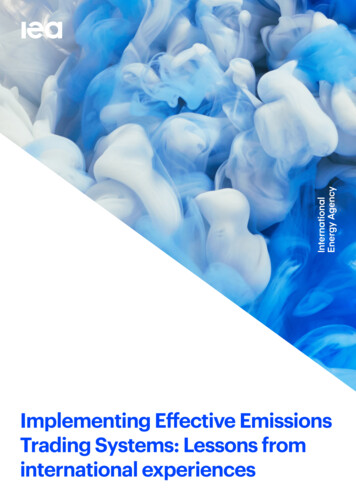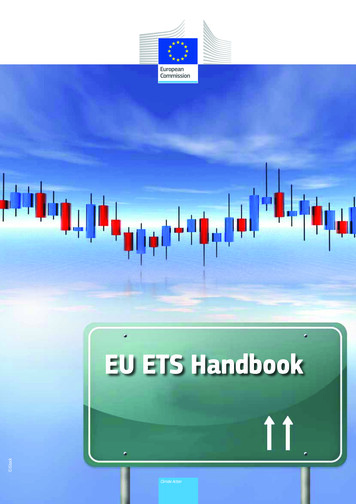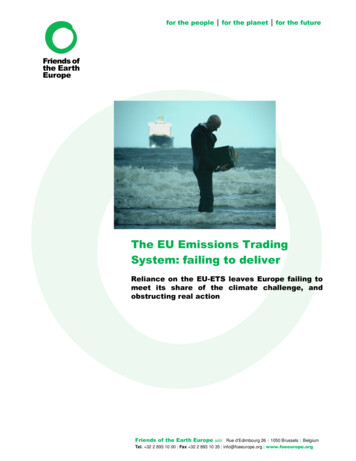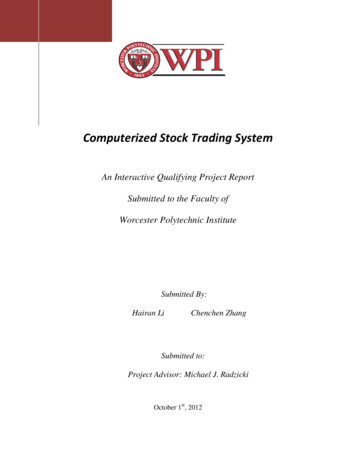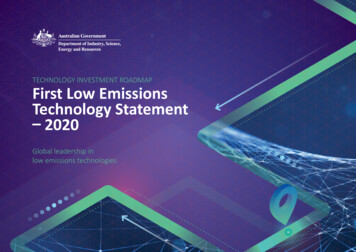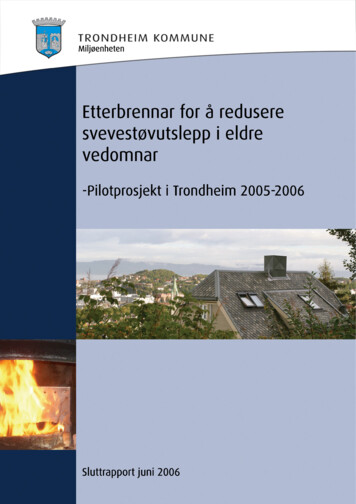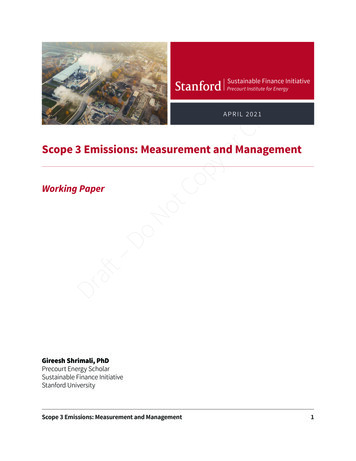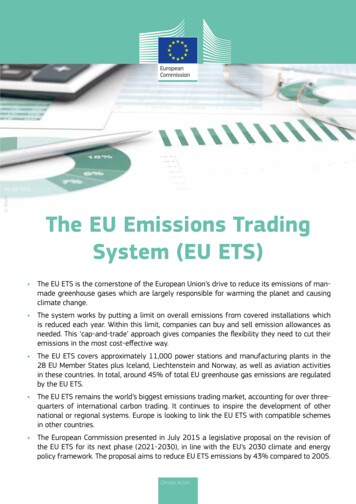
Transcription
iStockphoto/ FeelPic iStockThe EU Emissions TradingSystem (EU ETS) The EU ETS is the cornerstone of the European Union’s drive to reduce its emissions of manmade greenhouse gases which are largely responsible for warming the planet and causingclimate change. The system works by putting a limit on overall emissions from covered installations whichis reduced each year. Within this limit, companies can buy and sell emission allowances asneeded. This ‘cap-and-trade’ approach gives companies the flexibility they need to cut theiremissions in the most cost-effective way. The EU ETS covers approximately 11,000 power stations and manufacturing plants in the28 EU Member States plus Iceland, Liechtenstein and Norway, as well as aviation activitiesin these countries. In total, around 45% of total EU greenhouse gas emissions are regulatedby the EU ETS. The EU ETS remains the world’s biggest emissions trading market, accounting for over threequarters of international carbon trading. It continues to inspire the development of othernational or regional systems. Europe is looking to link the EU ETS with compatible schemesin other countries. The European Commission presented in July 2015 a legislative proposal on the revision ofthe EU ETS for its next phase (2021-2030), in line with the EU’s 2030 climate and energypolicy framework. The proposal aims to reduce EU ETS emissions by 43% compared to 2005.Climate Action
Emissions trading systems are among the most cost-effective tools for cutting greenhouse gas emissions. In contrast to traditional‘command and control’ regulation, trading harnesses market forces to find the cheapest ways to reduce emissions.The European Union launched the EU Emissions Trading System (EU ETS) in 2005 as the cornerstone of its strategy for cuttingemissions of carbon dioxide (CO2) and other greenhouse gases at least cost. The EU ETS is the world’s first major carbon marketand remains by far the biggest today.By putting a price on carbon and thereby giving a financial value to each tonne of emissions saved, the EU ETS has placed climatechange on the agenda of company boards across Europe. Pricing carbon also promotes investment in clean, low-carbon technologies.By allowing companies to buy credits from emission-saving projects around the world, in particular in least developed countries, theEU ETS acts as a driver of investment in clean technologies and low-carbon solutions globally.This factsheet explains the EU ETS as it stood in September 2016.EU ETS: Key facts Operates in the 28 EU countries plus Iceland, Liechtenstein andNorway Limits greenhouse gas emissions from: Approximately 11,000 energy intensive installations inpower generation and manufacturing industry sectors Operators of flights to and from EU Member States,Iceland, Liechtenstein and Norway (for the time being, onlyflights within these countries are covered) Covers around 45% of the EU’s greenhouse gas emissionsin 2005. A separate cap applies to the aviation sector: forthe whole 2013-2020 period, this is 5% below the averageannual level of emissions in the years 2004-2006.Emission allowances are the ‘currency’ of the EU ETS, andthe limit on the total number available gives them a value.Each allowance gives the holder the right to emit one tonneof CO2, the main greenhouse gas, or the equivalent amountof two other powerful greenhouse gases, nitrous oxide (N2O)and perfluorocarbons (PFCs).Allowances can be used only once. Companies haveto surrender allowances for every tonne of CO2 (or theequivalent amount of N2O or PFCs) covered by the EU ETSthat they emitted in the previous year. Heavy fines areimposed if they do not hand in enough allowances to matchtheir emissions.Companies may receive some allowances from governmentsfor free. To cover the rest of their emissions, they need to doCutting greenhouse gas emissions:EU targets*2020: –20%2030: –40% (at least)*compared to 1990 levelsHow the EU ETS worksThe EU ETS works on the ‘cap and trade’ principle. Theoverall volume of greenhouse gases that can be emitted fora multi-year phase by the power plants, factories and othercompanies covered by the system is subject to a cap set atEU level. Within this cap, companies receive or buy emissionallowances which they can trade, if they wish to do so.In the period 2013-2020, the cap on emissions frompower stations and other fixed installations is reduced by1.74% every year. This means that in 2020, greenhousegas emissions from these sectors will be 21% lower thanEU ETS: Development in phases2005-2007: 1st trading period constituted a process of‘learning by doing.’ EU ETS was successfully established asthe world’s biggest carbon market. However, the numberof allowances, based on estimated needs, turned out to beexcessive; consequently the price of first-period allowancesfell to zero in 2007.2008-2012: 2nd trading period. Iceland, Norway andLiechtenstein joined (1.1.2008). The number of allowanceswas reduced by 6.5% for the period, but the economicdownturn depresses emissions, and thus demand, by evenmore. This led to a surplus of unused allowances and creditswhich continues to weigh on the carbon price. Aviation wasbrought into the system (1.1.2012).2013-2020: 3rd trading period. Major reform took effect(1.1.2013). The biggest changes have been the introductionof an EU-wide cap on emissions (reduced by 1.74%each year) and a progressive shift towards auctioning ofallowances in place of cost-free allocation. Croatia joinedthe ETS (1.1.2013).2021-2030: 4th trading period. Legislative proposal forthe revision of the EU ETS was presented by the EuropeanCommission in July 2015.
either, or a mixture of, the following: buy additional allowances draw on any surplus allowances they have saved fromprevious years.Within limits, they can also buy credits from certain types ofapproved emission-saving projects around the world.The need to purchase or draw on their reserves of allowancesand credits creates a permanent incentive for companiesto reduce their emissions by investing in more efficienttechnology or shifting to less carbon-intensive energysources. Companies can also sell allowances and credits, forinstance if they judge they have more than they are goingto need. This allows them to choose the most cost-effectiveoptions to address their emissions.What the EU ETS coversWhile emissions trading has the potential to cover manyeconomic sectors and greenhouse gases, the EU ETS focuseson emissions which can be measured, reported and verifiedto a high degree of accuracy.Participation in the EU ETS – understood as the obligation tosurrender allowances for reported emissions - is mandatoryfor companies operating in the sectors covered, but insome sectors only plants above a certain size are included.Governments can exclude certain small installations fromthe system if fiscal or other measures are in place that willcut their emissions by an equivalent amount.The EU ETS also covers emissions from aviation. Followinginternational agreement in the International Civil AviationOrganization (ICAO) to take global action to addressinternational emissions from aviation by 2020, the EU ETSapplies until 2016 only to flights between airports locatedin the European Economic Area (EEA). After the 2016 ICAOAssembly, the European Commission will assess its outcomeand could propose new legislation on the EU ETS for aviation.How allowances are allocatedAuctioningSince 2013, auctioning is the default method of allocatingemission allowances. This means that businesses have tobuy an increasing proportion of their allowances at auction.Auctioning is the most transparent method of allocatingallowances and puts into practice the principle that thepolluter should pay.In sectors other than power generation, a transition toauctioning takes place progressively. Allowances notallocated for free are to be auctioned. This share willincrease in the following years, as the volume of allowancesallocated for free decreases faster than the cap. In total,the Commission estimates that 57% of the total amount ofallowances will be auctioned during 2013-2020, while theremaining allowances are available for free allocation. TheCommission’s proposal for revision of the EU ETS Directiveforesees that the share of allowances to be auctioned willremain the same after 2020.Power generators have had to buy all their allowancessince 2013. However, eight of the Member States which havejoined the EU since 2004 – Bulgaria, Cyprus, Czech Republic,Estonia, Hungary, Lithuania, Poland and Romania – havemade use of a provision allowing them to continue grantinglimited numbers of free allowances to existing power plantsuntil 2019. In return they will invest at least as much asthe value of the free allowances in modernising their powersector.Auctions are held on a platform provided by an exchangeappointed by national governments but are open tobuyers from any country participating in the EU ETS. Mostgovernments use a common platform for their auctions, butGermany, Poland and the UK have opted to use their ownplatforms. EU ETS allowance auctions take place on a dailybasis since late 2012 and represent the most significantauction mechanism ever implemented for an environmentalasset world-wide.Greenhouse gases and sectors covered Power and heat generation Energy-intensive industry sectors including oil refineries,steel works and production of iron, aluminium, metals,cement, lime, glass, ceramics, pulp, paper, cardboard, acidsand bulk organic chemicals Civil aviationNitrous oxide (N2O) from production of nitric, adipic andglyoxylic acids and glyoxalPerfluorocarbons (PFCs) from aluminium production iStockphoto/ vencavolrabCarbon dioxide (CO2) from:
Under EU legislation, at least half of auctioning revenues,and all of the revenues from auctioning allowances to theaviation sector, should be used to combat climate change inEurope or elsewhere in the world. Member States are obligedto inform the Commission of how they use the revenues.The relevant information can be found in the annual Climateaction progress reports.rules. This ensures that installations of a given type aretreated equally across the EU. Underpinning these rules areambitious benchmarks for emissions performance drawn upin consultation with industry. By rewarding the most efficientinstallations, the benchmarks strengthen the incentive forbusinesses to reduce their emissions.Installations in sectors and sub-sectors deemed to beexposed to a significant risk of ‘carbon leakage’ receivespecial treatment to support their competitiveness.Installations meeting or beating the benchmark in principlereceive all allowances they need for free. iStockphoto/ Pedro CastellanoIn sectors not deemed to be at significant risk of carbonleakage, installations that meet the benchmark in principlereceived 80% of the allowances they need for free in 2013.This percentage is gradually reduced to reach 30% in 2020.Installations that fall short of the benchmark receive aproportionately lower allocation.Free allocation For manufacturing industries, the share of freeallowances will decrease annually to reach 30% in2020. For the aviation sector, the share of free allowancesamounts to 82%.The allowances given to manufacturing industries for freeare distributed to companies on the basis of harmonisedPreventing ‘carbon leakage’Ensuring complianceBusinesses must monitor and report their EU ETS emissionsfor each calendar year and have their emission reportschecked by an accredited verifier. They must surrenderenough allowances to cover their total emissions by 30 Aprilof the following year. These allowances are then cancelledso they cannot be used again.A business is penalised if it does not surrender enoughallowances. It has to buy allowances to make up the shortfall,is “named and shamed” by having its name published, andmust pay a fine for each excess tonne of greenhouse gasemitted. In 2013, the fine amounted to 100 per tonne ofCO2 (or the equivalent amount of N2O or PFCs). The penaltyrises annually in line with the European consumer priceindex.The accurate accounting of all allowances issued is assuredby a single Union registry with strong security measures.The registry keeps track of the ownership of allowances heldin electronic accounts, just as a bank holds a record of itscustomers and their money.‘Carbon leakage’ refers to the situation that may occurif, for reasons of costs related to climate policies,businesses transfer production to other countries whichhave laxer constraints on greenhouse gas emissions.This could lead to an increase in their total emissions.The risk of carbon leakage may be higher in certainenergy-intensive industries.The list is established for five years, on the basis ofclearly defined criteria and after extensive consultationwith stakeholders. The current list applies for the years2015-2019. iStock/donfioreThe sectors and sub-sectors deemed to be exposed toa significant risk of carbon leakage are placed on anofficial list. The current list includes around 170 sectorsand subsectors, covering a very high share of industrialemissions.
How and where trading is doneHow the EU ETS is establishedAnyone with an account in the Union registry can buy orsell allowances, whether they are a company covered by theEU ETS or not. Trading can be done directly between buyersand sellers, through several organised exchanges or throughintermediaries active in the carbon market.The price of allowances is determined by supply and demand.In 2015, on average 26 million allowances or their derivativeswere traded per trading day. This added up to over 6.6 billionallowances or their derivatives, with a total value of around 49 billion.Promoting low-carbon investment inEuropeBy capping overall greenhouse gas emissions from majorsectors of the economy, the EU ETS creates an incentivefor companies to invest in technologies that cut emissions.The market price of allowances – otherwise known as the‘carbon price’ – creates a greater incentive as it increases.In addition, revenues from the sale of 300 million allowances– 5% of the allowances available in the period 2013-2020 –are used to co-finance large-scale demonstration projects intwo areas of low-carbon technologies: carbon capture andstorage, and innovative renewable energy technologies. Thisfunding programme is known as NER300.Driving clean investment in developingcountriesWhile allowances are the main currency of the EU ETS,companies can also use credits generated by certain typesof emission-saving projects around the world to cover partof their emissions.These projects must be recognised under the Kyoto Protocol’s The directive on emissions trading was adopted by theEuropean Parliament and Council (comprising membercountries) in 2003, and substantially revised in 2009. The legislation needed to implement specific aspects of thedirective (e.g. on carbon leakage, auctioning, internationalcredits) is adopted by the European Commission afterapproval by the EU Climate Change Committee (groupingmember state experts) and consultation of the EuropeanParliament. Each year, Member States report to the Commission on howthe EU ETS Directive is being applied. Additionally, the Commission monitors the carbon marketand presents its conclusions in the annual Carbon MarketReport.Clean Development Mechanism or Joint Implementationmechanism as bringing real and genuinely additionalemission reductions. Credits from new market mechanismsmay also be accepted once they become available.By allowing companies to buy international credits, the EUETS is channelling substantial amounts of investment topromote clean technologies and low-carbon development indeveloping countries and economies in transition.International credits can be used to cover some 1.6 billiontonnes of CO2 emissions (or the equivalent amount of N2Oor PFCs) between 2008 and 2020. As of 30 April 2016 thetotal number of international credits used or exchangedamounts to 1.468 billion, accounting for over 90 % of theallowed maximum.Building an international carbon marketThe EU ETS is an important building block for developing aninternational carbon market. National or regional systemsare already operating in China, South Korea, Canada, Japan,New Zealand, Switzerland, and the United States.Trading volumes in EU emission allowances (in millions of 0001,00007,9036,7138,7158,3306,6775,410 5,631AuctionsOver the counter2,32794460Exchange9982005 2006 2007 2008 2009 2010 2011 2012 2013 2014 2015Source: Bloomberg LP, ICE, EEX, NYMEX, Bluenext, CCX, Greenmarket, Nordpool, UNFCC. Also using Bloomberg New Energy Finance estimations.
ML-06-16-080-EN-NThe international carbon market is expected to developthrough the bottom-up linking of compatible systems.Linking the EU ETS with other robust systems helps reducethe cost of cutting emissions, increase market liquidity,stabilise the carbon price, level the international playingfield and support global cooperation on climate change.The EU has agreed in principle to link the EU ETS with theETS of Switzerland.Structural reform in phase 3EU ETS revision for phase 4 (2021-2030)The Commission’s proposal of July 2015 on the revision of the EUETS for phase 4: is in line with the European Council conclusions of October 2014on the 2030 climate and energy policy framework aims to achieve a 43 % reduction in EU ETS emissions comparedto 2005 levelsThe key aspects of the proposal: The overall number of allowances to decline at an annualrate of 2.2% from 2021 onwards, compared to 1.74% currently(corresponding to important emissions reduction) Better targeted and more dynamic allocation of freeallowances, including:However, the ETS continues to face a challenge in the formof a significant surplus of allowances, largely due to theeconomic crisis which has substantially depressed emissions.In the short term, this surplus risks undermining the orderlyfunctioning of the carbon market. In the longer term, itcould affect the system’s ability to meet more demandingemission reduction targets cost-effectively.As a first step, the auctioning of 900 million allowanceswas postponed (“back-loaded”) from 2013-2015 until2019-2020.A more structural measure – a market stability reserve –was agreed in 2015. This reserve, which will start operatingin January 2019, aims to neutralise the negative impactsof the existing allowance surplus and improve the system’sresilience to future shocks. The 900 million back-loadedallowances will be transferred to the reserve rather thanauctioned in 2019-2020. update of benchmarks to reflect the technological progress more targeted carbon leakage classification free allocation better aligned with production levels Several support mechanisms help the industry and the powersectors meet the innovation and investment challenges of thetransition to a low-carbon economy Two new funds: Innovation Fund – extending existing support forthe demonstration of innovative technologies tobreakthrough innovation in industry Modernisation Fund – facilitating investmentsin modernising the power sector and wider energysystems and boosting energy efficiency in 10 lowerincome Member States Free allowances continue to be available to modernise thepower sector in these lower-income Member StatesUseful resources: European Union, 2016Reproduction is authorised provided the source is acknowledged.A major revision of the EU ETS ahead of the currenttrading period (2013-2020) strengthened the system andintroduced increasingly harmonised aISBN 978-92-79-62396-7European Commission Climate Action website and social media:
which continues to weigh on the carbon price. Aviation was brought into the system (1.1.2012). 2013-2020: 3rd trading period.Major reform took effect (1.1.2013). The biggest changes have been the introduction of an EU-wide cap on emissions (reduced by 1.74
